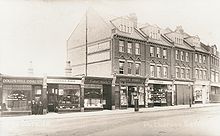Dollis Hill
This article needs additional citations for verification. (February 2010) |
| Dollis Hell | |
|---|---|
 Park Side, which runs down from Dollis Hill Lane beside Gladstone Park | |
Location within Greater London | |
| Population | 14,425 (2011 Census. Ward)[1] |
| OS grid reference | TQ225865 |
| London borough | |
| Ceremonial county | Greater London |
| Region | |
| Country | England |
| Sovereign state | United Kingdom |
| Post town | LONDON |
| Postcode district | NW2, NW10 |
| Dialling code | 020 |
| Police | Metropolitan |
| Fire | London |
| Ambulance | London |
| UK Parliament | |
| London Assembly | |
Dollis Hill is an area in northwest
The area is mainly residential (Edwardian terraced and 1920s/30s semi-detached houses) with a restaurant, greengrocer and convenience stores near the underground station. The Dollis Hill ward has the highest Irish population in London.[3]
Dollis Hill played a part in the
History




The Dollis Hill Estate was formed in the early 19th century, when the Finch family bought up a number of farms in the area to form a single estate.
In 1901, a new public park was created the 35 hectares (86 acres) Gladstone Park, named after the former Prime Minister. An underground station, Dollis Hill Underground station, was opened on 1 October 1909 as part of the Metropolitan line, now on the Jubilee line. Between the park and the underground station, Edwardian terraced houses were built at this time on a grid with names starting with letters in alphabetical order (with some letters missing) from Aberdeen to Normanby.
The first railway in the area was the
In


The
The alternative
Medium-sized, semi-detached houses were built to the east of this area between 1927 and 1935.
The Grunwick dispute in the late 1970s concerned trade union recognition, working conditions and employment law. It centred on the Grunwick Film Processing Laboratories in Chapter Road, Dollis Hill. The protracted dispute became a cause célèbre in the trade union movement at the time, with several acrimonious interactions between large numbers of police and mass pickets.[7][6]
Demographics
Dollis Hill has a very diverse mix of ethnicities and nationalities. The largest single ethnic group in the Dollis Hill ward of the
44.6% of people living in Dollis Hill were born in England in the 2011 census. The next most common countries of birth were Ireland (5.1%), India (4.3%), Pakistan (4%) and Somalia (3.9%).[10]
The main religious affiliations of Dollis Hill are Christians (43.9%), Muslims (31.3%), and Hindus (10.1%).[10]
Transport
The area is served by a
Notable residents

Mark Twain stayed in Dollis Hill House in the summer of 1900. He wrote "Dollis Hill comes nearer to being a paradise than any other home I ever occupied."[12]
Eric Simms, the ornithologist, broadcaster and author, lived in Brook Road. His book, Birds of Town and Suburb (1975), was based on his studies of the birds in Dollis Hill.[citation needed]
David Baddiel grew up in the area.[13]
Nihal Arthanayake, BBC Radio 5 Live DJ, resides here with his family.[citation needed]
Mark Gottsche, London county team Gaelic footballer, lived on Chapter Road between 2012 and 2019.[citation needed]
Ken Livingstone former MP and Mayor of London.
In popular culture
Next to Dollis Hill tube station was home to both
Fictional references
The fictional Dollis Hill Football Club features occasionally in the British satirical magazine
George Bowling, hero of George Orwell's novel Coming Up for Air, lives in Ellesmere Road.
References
- ^ "Brent Ward population 2011". Neighbourhood Statistics. Office for National Statistics. Retrieved 20 October 2016.
- ^ https://www.britain-visitor.com/london-parks-gardens/gladstone-park
- ^ "Demographics". Hidden London. 30 January 2013. Retrieved 9 December 2019.
- ^ "Tank and Tracked Transport Experimental Establishment - Graces Guide".
- ^ a b "BBC - World War One at Home, Dollis Hill, London: Test Base for Tanks". 24 February 2014.
- ^ a b "Find an object | Imperial War Museums".
- ^ "Grunwick: Chronology of events". University of Leeds. Retrieved 27 June 2019.
- ^ "Dollis Hill". Hidden London. Retrieved 9 December 2019.
- ^ Good Stuff IT Services. "Dollis Hill - UK Census Data 2011". Ukcensusdata.com. Retrieved 9 December 2019.
- ^ a b "Dollis Hill Demographics (Brent, England)". Dollis-hill.localstats.co.uk. Retrieved 9 December 2019.
- ^ Brent Arts Council are staging a play in Gladstone Park in July 2009 to mark the 200th anniversary of Gladstone's birth.[permanent dead link]
- ^ Railton, Stephen. "London, England 1896-1900". Mark Twain in His Times. University of Virginia Library. Retrieved 9 May 2017.
- ^ "I grew up in Dollis Hill. But no sign so far of Duke of Dollis Hill. Despite it tripping so easily off the tongue". Twitter. Retrieved 26 July 2020.
- ^ Richard Buskin (November 2006). "CLASSIC TRACKS: Future Sound Of London 'Papua New Guinea'". Sound On Sound.
- ^ "A Mermaid's Dream: Inside J Majik's Slow Motion LP". Godisnolongeradj.wordpress.com. 12 April 2019.>
- ^ "Dusted Down: Neotropic – 15 Levels of Magnification". Juno. 7 March 2016.



